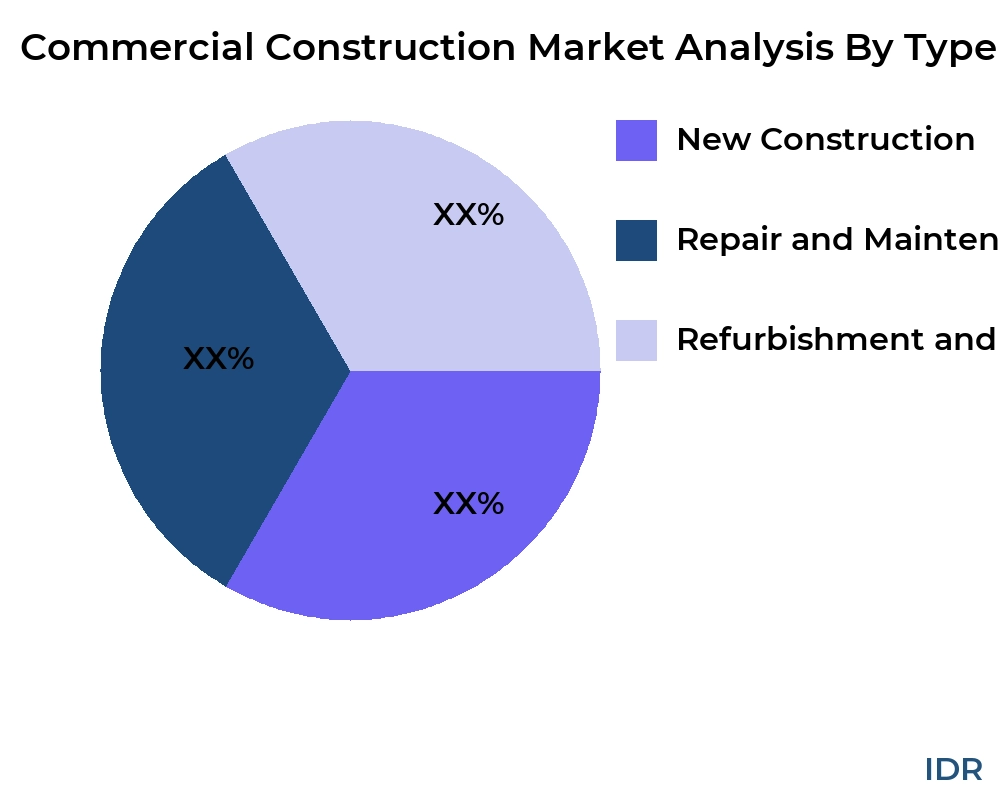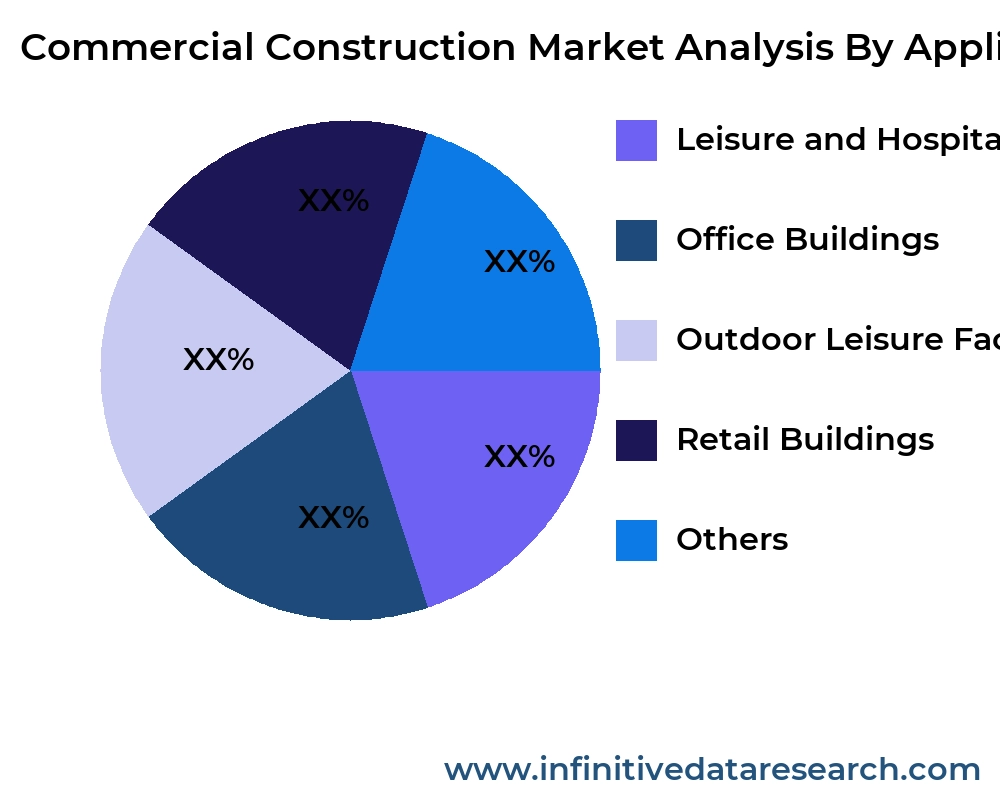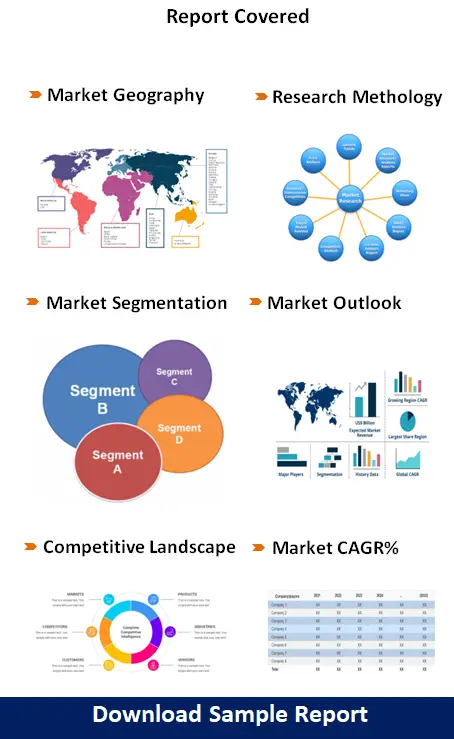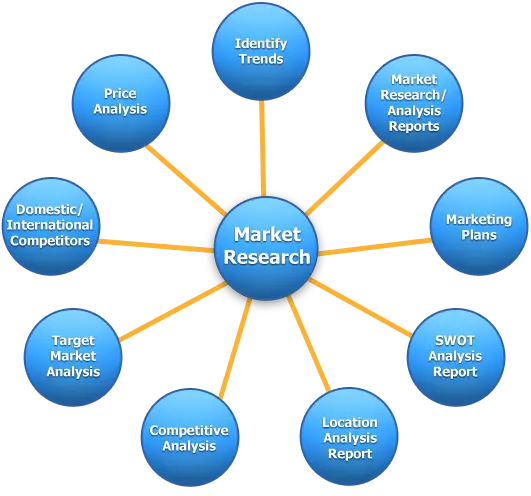Commercial Construction Market Growth CAGR Overview
According to research by Infinitive Data Research, the global Commercial Construction Market size was valued at USD 2.8 Bln (billion) in 2024 and is Calculated to reach USD 3.1 Bln (billion) by the end of 2032, growing at an anticipated compound annual growth rate (CAGR) of 4.3% during the forecast period 2024 to 2032. This projected growth is driven by its increasing adoption across Software & Services industries such as Leisure and Hospitality Buildings, Office Buildings, Outdoor Leisure Facilities, Retail Buildings, OthersThe commercial construction sector is driven by sustained urbanization and the expansion of business districts in both mature and emerging economies. As populations migrate towards cities, the demand for office towers, retail complexes, and mixed‑use developments surges, prompting developers to invest in land acquisition and vertical builds. Rising occupancy rates and elevated lease rates in prime urban centers further incentivize new projects, creating a feedback loop where strong market fundamentals attract capital, which in turn fuels additional construction activity.
Innovations in digital project management and Building Information Modeling (BIM) have fundamentally transformed how projects are designed, scheduled, and executed. Stakeholders now collaborate in real time, enabling rapid iteration of designs and swift identification of conflicts before they materialize on site. This digital integration reduces delays and cost overruns, enhancing overall project predictability. It also fosters a more transparent supply chain, as material orders, subcontractor schedules, and regulatory approvals are tracked through centralized platforms.
Sustainability has become a defining feature of modern commercial builds, with green certifications like LEED and WELL driving adoption of energy‑efficient designs, renewable energy integration, and waste‑minimization strategies. Developers are increasingly committing to net‑zero targets, which necessitate advanced façade systems, high‑performance HVAC, and smart building controls. These requirements have not only elevated construction complexity but also opened opportunities for specialist contractors and technology providers focused on sustainable solutions.
Global geopolitical shifts and fluctuating interest rates exert a strong influence on project financing and risk assessment. While low‑interest regimes have historically underpinned debt‑financed projects, recent tightening cycles have raised borrowing costs, compelling developers to optimize capital structures and pursue joint ventures with institutional investors. Simultaneously, supply‑chain disruptions—exacerbated by trade tensions or logistics bottlenecks—can impact material availability and pricing, requiring agile procurement strategies and contingency planning to maintain project momentum.

>>> Understand The Key Trends Shaping This Market:- Download PDF Sample
Commercial Construction Market Growth Factors
Steady economic growth and corporate expansion are primary engines driving demand for new commercial spaces. As businesses scale operations or upgrade facilities, they fuel tenant demand in prime real estate markets. This cyclical pattern of corporate growth and real estate development underpins long‑term construction pipelines, with major metropolitan areas consistently absorbing new office and retail supply.
Technological advances in modular and offsite construction are accelerating project delivery times and reducing on‑site labor requirements. Prefabricated structural components, bathroom pods, and MEP assemblies are manufactured under controlled conditions, improving quality and cutting waste, while enabling tight scheduling windows. This trend is especially pronounced in markets with high labor costs or tight urban land constraints, where minimizing disruption and accelerating occupancy is essential.
Public–private partnerships (PPPs) are emerging as a vital mechanism for funding large‑scale commercial projects, particularly in infrastructure‑adjacent developments like transit‑oriented complexes and logistics parks. Governments leverage private capital and expertise to deliver projects more efficiently, sharing revenue risks and aligning long‑term interests. These collaborative structures broaden the project universe beyond purely speculative builds, enabling new asset classes such as data‑center campuses and urban innovation hubs.
Rising focus on tenant experience and wellness is reshaping interior fit‑out specifications and driving demand for smart building technologies. Developers are integrating IoT sensors, advanced air filtration, and adaptive lighting systems to attract premium tenants and command higher rents. These enhancements not only differentiate new developments but also support sustainability goals by optimizing energy use and occupant comfort.
Market Analysis By Competitors
- Vinci
- Grupo ACS
- Bechtel
- Hochtief
- Balfour Beatty
- Bouygues Construction
- Kiewit
- Royal BAM Group
- Laing O'Rourke
By Product Type
- New Construction
- Repair and Maintenance
- Refurbishment and Demolition
By Application
- Leisure and Hospitality Buildings
- Office Buildings
- Outdoor Leisure Facilities
- Retail Buildings
- Others
>>> Understand The Key Trends Shaping This Market:- Understand The Key Trends Shaping This Market:-
Commercial Construction Market Segment Analysis
Distribution Channel
The distribution of construction services is orchestrated through a network of general contractors, specialist subcontractors, design‑build firms, and material suppliers. General contractors contract directly with developers and coordinate specialist trades, while design‑build entities offer turnkey capabilities that integrate architecture, engineering, and construction under a single agreement. Material distributors and manufacturers maintain local warehouses and digital ordering platforms to ensure just‑in‑time delivery, reducing on‑site storage requirements. Strategic partnerships between global suppliers and regional contractors help streamline logistics and maintain continuity in multi‑site portfolios.
Compatibility
Compatibility in commercial construction refers to the ability to integrate new builds with existing urban infrastructure and legacy systems. Developers must ensure seamless connectivity to utility grids, fiber networks, and public transit while adhering to zoning and landmark preservation regulations. Modular designs and flexible floor plates facilitate future tenant fit‑outs, and open‑protocol building management systems (BMS) ensure interoperability among mechanical, electrical, and IT subsystems. As workplace requirements evolve, buildings designed for easy reconfiguration—through raised floors and removable partitions—offer enduring value.
Price
Pricing strategies in commercial construction are heavily influenced by material costs, labor rates, and regional regulatory burdens. In high‑cost markets, contractors may adopt value‑engineering techniques to optimize structural systems and reduce expensive finishes without compromising performance. Cost‑plus and guaranteed‑maximum‑price (GMP) contracts remain common, each presenting different risk profiles for owners and builders. Competitive bidding drives down margins for commodity trades, while specialist services—such as façade engineering and advanced MEP—command premium rates due to technical complexity and liability considerations.
Product Type
Commercial construction product types range from speculative office towers and retail malls to build‑to‑suit industrial parks and hospitality complexes. Within office developments, product tiers reflect class A, B, and C designations, with corresponding finishes, amenities, and sustainability certifications. Retail projects vary from neighborhood strip centers to large‑format super‑regional malls, each requiring tailored structural, architectural, and parking solutions. Specialty segments like life‑science labs and data‑center campuses demand high‑reliability power and cooling infrastructure, driving collaboration between construction firms and technical system integrators.
| REPORT ATTRIBUTES | DETAILS |
|---|---|
| Study Period |
2019-2032 |
| Base Year |
2023 |
| Forecast Period |
2024-2032 |
| Historical Period |
2019-2022 |
| Unit |
Value (USD Billion) |
| Key Companies Profiled |
Vinci, Grupo ACS, Bechtel, Hochtief, Balfour Beatty, Bouygues Construction, Kiewit, Royal BAM Group, Laing O'Rourke |
| Segments Covered |
By Product |
| Customization Scope |
Free report customization (equivalent to up to 3 analyst working days) with purchase. Addition or alteration to country, regional and segment scope |
>>> Overview of Market Analysis:- Download PDF Sample
Commercial Construction Market Regional Analysis
North America remains a dominant market for commercial construction, buoyed by strong corporate expansion, robust institutional investment flows, and the densification of technology hubs. Major cities such as New York, San Francisco, and Dallas continue to attract capital for premium office developments, while Sun Belt metros benefit from lower costs and population growth. Cross‑border capital flows, particularly from Asia and Europe, further support high‑profile projects, with investors seeking yield in stable markets.
Europe’s commercial construction landscape is shaped by stringent sustainability mandates and heritage‑conservation considerations. Markets in London, Frankfurt, and Paris emphasize retrofits and redevelopment to achieve carbon‑neutral targets, driving demand for high‑performance refurbishment services alongside new builds. Emerging markets in Central and Eastern Europe are witnessing catch‑up growth, fueled by multinational relocations and the expansion of logistics real estate.
Asia‑Pacific is the fastest‑growing region, with aggressive urbanization in China, India, and Southeast Asia fueling billions in new office, retail, and mixed‑use developments. Government policies promoting smart‑city initiatives and infrastructure investment further accelerate construction pipelines. Land scarcity in major Asian capitals has sparked vertical megaprojects and integrated townships, combining commercial, residential, and transit components in single masterplanned communities.
Latin America, the Middle East, and Africa exhibit diverging growth trajectories. Major Gulf cities—Dubai, Riyadh, and Doha—invest heavily in mega mixed‑use developments and free‑zone districts, supported by sovereign wealth and tourism‑driven demand. In Latin America, Brazil and Mexico lead commercial expansions in logistics and retail, while sub‑Saharan Africa’s urban centers are at earlier stages of office and hospitality growth, driven by private investment and diaspora‑funded projects.
global Commercial Construction market revenue (usd million) comparison by players 2024-2032
| Company/players | 2021 | 2022 | 2023 | 2024 | ... | (2032) |
|---|---|---|---|---|---|---|
| Vinci | XX | XX | XX | XX | XX | XX |
| Grupo ACS | XX | XX | XX | XX | XX | XX |
| Bechtel | XX | XX | XX | XX | XX | XX |
| Hochtief | XX | XX | XX | XX | XX | XX |
| Balfour Beatty | XX | XX | XX | XX | XX | XX |
| Bouygues Construction | XX | XX | XX | XX | XX | XX |
| Kiewit | XX | XX | XX | XX | XX | XX |
| Royal BAM Group | XX | XX | XX | XX | XX | XX |
| Laing O'Rourke | XX | XX | XX | XX | XX | XX |
| Total | XX | XX | XX | XX | XX | XX |
global Commercial Construction market revenue (usd million) comparison by product type 2024-2032
Product Type
2023
2024
...
2032
CAGR%(2024-32)
New Construction
XX
XX
XX
XX
XX
Repair and Maintenance
XX
XX
XX
XX
XX
Refurbishment and Demolition
XX
XX
XX
XX
XX
Total
XX
XX
XX
XX
XX
| Product Type | 2023 | 2024 | ... | 2032 | CAGR%(2024-32) |
|---|---|---|---|---|---|
| New Construction | XX | XX | XX | XX | XX |
| Repair and Maintenance | XX | XX | XX | XX | XX |
| Refurbishment and Demolition | XX | XX | XX | XX | XX |
| Total | XX | XX | XX | XX | XX |
global Commercial Construction market revenue (usd million) comparison by application 2024-2032
Application
2023
2024
...
2032
CAGR%(2024-32)
Leisure and Hospitality Buildings
XX
XX
XX
XX
XX
Office Buildings
XX
XX
XX
XX
XX
Outdoor Leisure Facilities
XX
XX
XX
XX
XX
Retail Buildings
XX
XX
XX
XX
XX
Others
XX
XX
XX
XX
XX
Total
XX
XX
XX
XX
XX
| Application | 2023 | 2024 | ... | 2032 | CAGR%(2024-32) |
|---|---|---|---|---|---|
| Leisure and Hospitality Buildings | XX | XX | XX | XX | XX |
| Office Buildings | XX | XX | XX | XX | XX |
| Outdoor Leisure Facilities | XX | XX | XX | XX | XX |
| Retail Buildings | XX | XX | XX | XX | XX |
| Others | XX | XX | XX | XX | XX |
| Total | XX | XX | XX | XX | XX |
>>> Market Understand Through Graph And Chart:- Download PDF Sample


Commercial Construction Market Competitive Insights
The competitive landscape of commercial construction is dominated by global contractors with extensive geographic reach and technical capabilities. These firms leverage scale to secure mega‑projects through integrated design‑build offerings, strong balance sheets, and relationships with institutional investors. They compete on the basis of track record, risk management acumen, and ability to deliver complex projects on time and budget.
Mid‑tier and specialist contractors differentiate themselves through deep local market knowledge and niche capabilities. In mature markets, they excel in fit‑out, façade engineering, and sustainability‑focused retrofits. Their agility and cost structure allow them to pursue projects that may be below the threshold of multinational firms, creating price‑competitive pressure and innovation in delivery models.
Technology integration is reshaping competitive dynamics, as firms that adopt digital twins, AI‑driven scheduling, and advanced robotics gain efficiency advantages. Early adopters of autonomous equipment and drone‑based site monitoring achieve tighter quality control and accelerated timelines, which become key selling points in proposals to savvy developers.
Sustainability expertise is emerging as a critical differentiator. Contractors partnering with green consultants and energy‑modeling firms can offer higher certification levels and lower life‑cycle costs. This competency not only secures premium projects but also aligns firms with corporate ESG mandates, enabling long‑term client retention.
Commercial Construction Market Competitors
United States:
-
Turner Construction
-
Bechtel
-
Skanska USA
-
Jacobs Engineering
-
Fluor
Germany:
-
HOCHTIEF
-
Bauer
-
Bilfinger
-
Züblin
-
Max Bögl
Japan:
-
Shimizu Corporation
-
Obayashi Corporation
-
Kajima Corporation
-
Taisei Corporation
-
Takenaka Corporation
China:
-
China State Construction Engineering Corporation
-
China Railway Group
-
China Metallurgical Group
-
China Communications Construction Company
-
Shanghai Construction Group
United Kingdom:
-
Balfour Beatty
-
Laing O’Rourke
-
Morgan Sindall
-
Kier Group
-
Costain Group
India:
-
Larsen & Toubro
-
Tata Projects
-
Shapoorji Pallonji
-
GMR Group
-
Sobha Limited
Commercial Construction Market Top Competitors
Turner Construction
Turner Construction is one of North America’s leading general contractors, consistently ranking among the top by revenue. The firm offers full‑service construction management, design‑build, and integrated project delivery, catering to commercial, healthcare, education, and sports facilities. Its robust backlog includes iconic skyscrapers, convention centers, and mixed‑use complexes. Turner’s extensive regional network of offices allows it to mobilize quickly on multiple concurrent projects, leveraging standardized processes and safety protocols. Its investment in digital project platforms and lean construction practices has enhanced on‑time delivery and cost control. Turner’s strong financial position and diversified portfolio make it a preferred partner for institutional investors seeking reliable execution on high‑profile assets.
Bechtel
Bechtel is a global engineering, procurement, and construction titan with diversified operations spanning infrastructure, energy, and commercial developments. Renowned for tackling megaprojects—such as airport terminals, urban transit systems, and large‑scale office campuses—Bechtel’s technical prowess is backed by deep in‑house engineering capabilities. The company’s vertically integrated model ensures end‑to‑end control, from feasibility studies and financing to operations support. While historically focused on heavy civil and energy, Bechtel has expanded its commercial construction arm through strategic hires and technology acquisitions. Its emphasis on safety and risk management is recognized industry‑wide, enabling it to secure complex PPP contracts and maintain a healthy pipeline amidst cyclical markets.
Skanska USA
Skanska USA, the American arm of Sweden’s Skanska AB, specializes in green building and sustainable urban development. With a strong commitment to achieving net‑zero carbon in operations, Skanska has delivered numerous LEED Platinum projects, including office towers and corporate campuses. The company’s expertise in sustainable concrete, low‑carbon worksite practices, and circular economy principles differentiates it in environmentally conscious markets. Skanska leverages parent‑company R&D to pilot innovative construction methods—such as modular structural components—and applies them to large commercial projects. Its collaborative culture and focus on workforce well‑being have fostered long‑standing relationships with major corporate and public sector clients.
HOCHTIEF
HOCHTIEF is Germany’s largest contractor, with a broad European and North American presence. Its commercial division delivers everything from high‑rise office towers to logistics parks, often in partnership with Turner Construction. HOCHTIEF’s strength lies in complex urban projects that require intricate stakeholder management and rigorous compliance with heritage‑protection regulations. The company has pioneered building envelope innovations—such as adaptive shading systems and double‑skin façades—that improve energy performance. With a focus on digital engineering and robotics for façade assembly, HOCHTIEF maintains tight schedules and high safety standards. Its deep order book and diversified service lines help buffer against regional market fluctuations.
China State Construction Engineering Corporation
China State Construction Engineering Corporation (CSCEC) is the world’s largest construction company by revenue, dominating both domestic and international commercial markets. CSCEC’s scale allows it to pursue massive mixed‑use megaprojects across Asia, Africa, and the Middle East. The firm’s in‑house design institutes and prefabrication yards facilitate rapid, cost‑effective delivery. While its strength in state‑backed projects gives it pipeline certainty, CSCEC faces increasing competition from private developers in key urban centers seeking higher quality and more innovative designs. To address this, CSCEC has invested in BIM, VR planning tools, and advanced materials to elevate its product offering and meet evolving client expectations.
Larsen & Toubro
Larsen & Toubro (L&T) is India’s premier engineering and construction conglomerate, with a substantial commercial construction division. L&T’s portfolio includes corporate office parks, large‑scale retail malls, and integrated townships. The company’s vertical integration—spanning engineering, fabrication, and site execution—ensures tight quality control and schedule adherence. L&T has been an early adopter of modular construction techniques in India, delivering high‑rise podiums and pre‑engineered building modules at scale. Its strong balance sheet and government partnerships have enabled it to secure strategic urban redevelopment and transit‑oriented projects, positioning it as a national champion in commercial infrastructure.
Shimizu Corporation
Shimizu Corporation is one of Japan’s Big Five contractors, renowned for its engineering excellence and commitment to innovation. Shimizu has delivered landmark commercial projects—such as high‑performance data‑center complexes and earthquake‑resilient office towers—by integrating proprietary vibration‑isolation and seismic dampening systems. The company’s focus on R&D in smart materials and prefabrication enables it to meet stringent Japanese building codes and achieve remarkable construction speeds. Shimizu’s global reach extends into Southeast Asia, where it leverages its technical know‑how to compete for international bids. Its reputation for reliability and cutting‑edge engineering makes Shimizu a preferred contractor for mission‑critical commercial developments.
Balfour Beatty
Balfour Beatty is the UK’s largest construction services company, specializing in large commercial, transportation, and utilities projects. Its commercial construction arm handles major office campus developments in London and regional business parks. Balfour Beatty differentiates itself through integrated services—covering construction, facilities management, and digital infrastructure deployment. The company has invested in autonomous earthmoving equipment and offsite fabrication to improve safety and productivity. Its expertise in complex stakeholder environments—navigating heritage listings and community consultations—has solidified its role in high‑profile urban regeneration schemes. Balfour Beatty’s broad service suite and strong public‑sector partnerships underpin its market leadership.
Laing O’Rourke
Laing O’Rourke is a UK‑headquartered, family‑owned contractor known for its advanced manufacturing capabilities and offsite construction technology. The firm produces modular structural elements and MEP pods in dedicated factories, which are then assembled on site, accelerating schedules and enhancing quality. Laing O’Rourke’s “Digital Factory” concept integrates BIM, robotics, and automation to drive down waste and improve safety. Its commercial project portfolio spans from luxury retail flagships in global gateway cities to build‑to‑suit corporate headquarters. The company’s long‑term vision includes ambitious sustainability targets, with a focus on circular material flows and carbon‑neutral operations, further strengthening its competitive position.
Obayashi Corporation
Obayashi Corporation is a major Japanese contractor with diversified expertise across commercial, residential, and infrastructure sectors. Obayashi’s commercial division excels in constructing ultra‑tall buildings and complex mixed‑use towers, leveraging proprietary high‑strength concrete and modular core assembly techniques. The company’s R&D arm focuses on self‑healing concrete and energy‑harvesting façades, which enhance building longevity and sustainability. Obayashi’s strategic partnerships with global design firms and its ability to tailor solutions to local seismic and climate conditions make it a formidable competitor in Asia‑Pacific markets. Its disciplined project management and risk‑control systems ensure delivery of high‑value commercial assets to demanding clientele.
The report provides a detailed analysis of the Commercial Construction market across various regions, highlighting the unique market dynamics and growth opportunities in each region.
- US
- Canada
- Mexico
- UK
- Germany
- France
- Italy
- Russia
- Spain
- Switzerland
- Austria
- Belgium
- Rest of Europe
- China
- Japan
- South Korea
- Indonesia
- Vietnam
- Philippines
- Australia
- Thailand
- Singapore
- Rest of APAC
- UAE
- Saudi Arabia
- Egypt
- South Africa
- Israel
- Rest of MEA
- Brazil
- Argentina
- Rest of Latin America
>>> Need A Different Region Or Segment? Download PDF Sample
Key Takeaways
- The global Commercial Construction market is expected to grow significantly from 2024 to 2032, driven by technological advancements, increasing demand, and government investments in urbanization.
- The market is characterized by a diverse range of manufacturers, product types, and applications, catering to different consumer needs and preferences.
- Regional insights highlight the unique market dynamics and growth opportunities in various regions, including North America, Europe, Asia-Pacific, Latin America, and the Middle East & Africa.
- The competitive landscape features key players who have created a dynamic and diverse market environment through collaborations, mergers and acquisitions, and innovative product developments.
- Market trends such as technological advancements, sustainability, customization, and digital transformation are shaping the growth and development of the Commercial Construction market.
- Despite the positive outlook, the market faces challenges such as regulatory compliance, high initial investment costs, and economic uncertainties.
- The report provides comprehensive coverage of market size, market share, growth factors, and strategic insights to help businesses navigate the dynamic Commercial Construction market and achieve long-term success.
By leveraging the information provided in this report, businesses can develop effective strategies, address market challenges, and capitalize on growth opportunities to ensure sustainable growth and long-term success in the global Commercial Construction market.
- Introduction
- Objectives of the Study
- Market Definition
- Research Scope
- Currency
- Key Target Audience
- Research Methodology and Assumptions
- Executive Summary
- Premium Insights
- Porter’s Five Forces Analysis
- Value Chain Analysis
- Top Investment Pockets
- Industry Trends
- Market Dynamics
- Market Evaluation
- Drivers
- Restraints
- Opportunities
- Challenges
- Global Commercial Construction Market Analysis and Projection, By Companies
- Segment Overview
- Vinci
- Grupo ACS
- Bechtel
- Hochtief
- Balfour Beatty
- Bouygues Construction
- Kiewit
- Royal BAM Group
- Laing O'Rourke
- Global Commercial Construction Market Analysis and Projection, By Type
- Segment Overview
- New Construction
- Repair and Maintenance
- Refurbishment and Demolition
- Global Commercial Construction Market Analysis and Projection, By Application
- Segment Overview
- Leisure and Hospitality Buildings
- Office Buildings
- Outdoor Leisure Facilities
- Retail Buildings
- Others
- Global Commercial Construction Market Analysis and Projection, By Regional Analysis
- North America
- US
- Canada
- Mexico
- Europe
- UK
- Germany
- France
- Italy
- Russia
- Spain
- Switzerland
- Austria
- Belgium
- Rest of Europe
- Asia Pacific
- China
- Japan
- South Korea
- Indonesia
- Vietnam
- Philippines
- Australia
- Thailand
- Singapore
- Rest of APAC
- Middle East
- UAE
- Saudi Arabia
- Egypt
- South Africa
- Israel
- Rest of MEA
- Latin America
- Brazil
- Argentina
- Rest of Latin America
- Global Commercial Construction Market-Competitive Landscape
- Overview
- Market Share of Key Players in the Commercial Construction Market
- Global Company Market Share
- North America Company Market Share
- Europe Company Market Share
- APAC Company Market Share
- Competitive Situations and Trends
- Coverage Launches and Developments
- Partnerships, Collaborations, and Agreements
- Mergers & Acquisitions
- Expansions
- Company Profiles
- Vinci
- Business Overview
- Company Snapshot
- Company Market Share Analysis
- Company Coverage Portfolio
- Recent Developments
- SWOT Analysis
- Grupo ACS
- Business Overview
- Company Snapshot
- Company Market Share Analysis
- Company Coverage Portfolio
- Recent Developments
- SWOT Analysis
- Bechtel
- Business Overview
- Company Snapshot
- Company Market Share Analysis
- Company Coverage Portfolio
- Recent Developments
- SWOT Analysis
- Hochtief
- Business Overview
- Company Snapshot
- Company Market Share Analysis
- Company Coverage Portfolio
- Recent Developments
- SWOT Analysis
- Balfour Beatty
- Business Overview
- Company Snapshot
- Company Market Share Analysis
- Company Coverage Portfolio
- Recent Developments
- SWOT Analysis
- Bouygues Construction
- Business Overview
- Company Snapshot
- Company Market Share Analysis
- Company Coverage Portfolio
- Recent Developments
- SWOT Analysis
- Kiewit
- Business Overview
- Company Snapshot
- Company Market Share Analysis
- Company Coverage Portfolio
- Recent Developments
- SWOT Analysis
- Royal BAM Group
- Business Overview
- Company Snapshot
- Company Market Share Analysis
- Company Coverage Portfolio
- Recent Developments
- SWOT Analysis
- Laing O'Rourke
- Business Overview
- Company Snapshot
- Company Market Share Analysis
- Company Coverage Portfolio
- Recent Developments
- SWOT Analysis
List of Table
- Drivers of Global Commercial Construction Market: Impact Analysis
- Restraints of Global Commercial Construction Market: Impact Analysis
- Global Commercial Construction Market, By Technology, 2023-2032(USD Billion)
- global New Construction, Commercial Construction Market, By Region, 2023-2032(USD Billion)
- global Repair and Maintenance, Commercial Construction Market, By Region, 2023-2032(USD Billion)
- global Refurbishment and Demolition, Commercial Construction Market, By Region, 2023-2032(USD Billion)
- global Leisure and Hospitality Buildings, Commercial Construction Market, By Region, 2023-2032(USD Billion)
- global Office Buildings, Commercial Construction Market, By Region, 2023-2032(USD Billion)
- global Outdoor Leisure Facilities, Commercial Construction Market, By Region, 2023-2032(USD Billion)
- global Retail Buildings, Commercial Construction Market, By Region, 2023-2032(USD Billion)
- global Others, Commercial Construction Market, By Region, 2023-2032(USD Billion)
List of Figures
- Global Commercial Construction Market Segmentation
- Commercial Construction Market: Research Methodology
- Market Size Estimation Methodology: Bottom-Up Approach
- Market Size Estimation Methodology: Top-down Approach
- Data Triangulation
- Porter’s Five Forces Analysis
- Value Chain Analysis
- Top investment pocket in the Commercial Construction Market
- Top Winning Strategies, 2023-2032
- Top Winning Strategies, By Development, 2023-2032(%)
- Top Winning Strategies, By Company, 2023-2032
- Moderate Bargaining power of Buyers
- Moderate Bargaining power of Suppliers
- Moderate Bargaining power of New Entrants
- Low threat of Substitution
- High Competitive Rivalry
- Restraint and Drivers: Commercial Construction Market
- Commercial Construction Market Segmentation, By Technology
- Commercial Construction Market For Live Attenuated, By Region, 2023-2033 ($ Billion)
- Global Commercial Construction Market, By Technology, 2023-2032(USD Billion)
- global New Construction, Commercial Construction Market, By Region, 2023-2032(USD Billion)
- global Repair and Maintenance, Commercial Construction Market, By Region, 2023-2032(USD Billion)
- global Refurbishment and Demolition, Commercial Construction Market, By Region, 2023-2032(USD Billion)
- global Leisure and Hospitality Buildings, Commercial Construction Market, By Region, 2023-2032(USD Billion)
- global Office Buildings, Commercial Construction Market, By Region, 2023-2032(USD Billion)
- global Outdoor Leisure Facilities, Commercial Construction Market, By Region, 2023-2032(USD Billion)
- global Retail Buildings, Commercial Construction Market, By Region, 2023-2032(USD Billion)
- global Others, Commercial Construction Market, By Region, 2023-2032(USD Billion)
- Vinci: Net Sales, 2023-2033 ($ Billion)
- Vinci: Revenue Share, By Segment, 2023 (%)
- Vinci: Revenue Share, By Region, 2023 (%)
- Grupo ACS: Net Sales, 2023-2033 ($ Billion)
- Grupo ACS: Revenue Share, By Segment, 2023 (%)
- Grupo ACS: Revenue Share, By Region, 2023 (%)
- Bechtel: Net Sales, 2023-2033 ($ Billion)
- Bechtel: Revenue Share, By Segment, 2023 (%)
- Bechtel: Revenue Share, By Region, 2023 (%)
- Hochtief: Net Sales, 2023-2033 ($ Billion)
- Hochtief: Revenue Share, By Segment, 2023 (%)
- Hochtief: Revenue Share, By Region, 2023 (%)
- Balfour Beatty: Net Sales, 2023-2033 ($ Billion)
- Balfour Beatty: Revenue Share, By Segment, 2023 (%)
- Balfour Beatty: Revenue Share, By Region, 2023 (%)
- Bouygues Construction: Net Sales, 2023-2033 ($ Billion)
- Bouygues Construction: Revenue Share, By Segment, 2023 (%)
- Bouygues Construction: Revenue Share, By Region, 2023 (%)
- Kiewit: Net Sales, 2023-2033 ($ Billion)
- Kiewit: Revenue Share, By Segment, 2023 (%)
- Kiewit: Revenue Share, By Region, 2023 (%)
- Royal BAM Group: Net Sales, 2023-2033 ($ Billion)
- Royal BAM Group: Revenue Share, By Segment, 2023 (%)
- Royal BAM Group: Revenue Share, By Region, 2023 (%)
- Laing O'Rourke: Net Sales, 2023-2033 ($ Billion)
- Laing O'Rourke: Revenue Share, By Segment, 2023 (%)
- Laing O'Rourke: Revenue Share, By Region, 2023 (%)
Infinitive Data Research provides comprehensive market research, offering in-depth market analysis to help companies understand their target market and industry competition. This research predicts the market acceptance of your brand and products, ensuring informed decision-making for business success.
Competitor Analysis in the Commercial Construction Industry
Conducting a competitor analysis involves identifying competitors within the Commercial Construction industry and studying their various marketing strategies. This comparative data allows you to assess your company's strengths and weaknesses relative to competitors, providing insights to enhance your market position.
Importance of Continuous Market Research
Consistently conducting market research is essential for minimizing risk at every stage of business operations. Commercial Construction market research enables you to collect qualitative and quantitative data, which, when properly analyzed, leads to wise decisions that align with user and customer needs. Below are some crucial lessons learned through the Commercial Construction market research process:

Key Dimensions of Commercial Construction Market Analysis
- Trend and Pattern Identification: Analyzing data to spot market trends and patterns.
- Pricing Analysis: Assessing keyword pricing strategies.
- Actionable Insights: Implementing insights derived from data analysis.
- Market Potential: Evaluating the potential of the Commercial Construction market.
- Competitor Analysis: Studying competitors' strategies and performance.
- Location Analysis: Assessing optimal locations for market penetration.
- Distribution Channels Analysis: Evaluating the effectiveness of distribution channels.
- Market Size and Growth Rate: Measuring market size and growth potential.
- Market Profitability: Assessing profitability prospects.
- Key Success Factors: Identifying critical factors for success.
- Cost Structure: Understanding the cost structure within the Commercial Construction industry.
Target Audience for the Report
This report is valuable for a diverse audience, including:
- Commercial Construction Market Manufacturers: To understand market dynamics and enhance production strategies.
- Investors and Financing Companies: To assess investment opportunities and risks.
- Commercial Construction Market Suppliers: To identify market demands and supply chain efficiencies.
Necessity of the Report
Making Crucial Business Decisions
Understanding the Commercial Construction market, competition, and industry landscape is vital for making informed business decisions. Without current and relevant market research, decisions may be based on outdated or irrelevant information, potentially harming the business.
Securing Investment Funds
Attracting investors requires demonstrating thorough market research. Investors need assurance that you understand the sector, current and potential competition, and whether your idea addresses a market need.
Identifying New Business Opportunities
Commercial Construction market research goes beyond understanding trends and consumer behavior. It identifies new revenue streams and opportunities for business pivots. These insights can lead to strategic changes in the business model, promoting growth and adapting to market challenges.
Avoiding Business Failures
Market research also plays a crucial role in risk mitigation. It can reveal when not to pursue certain actions, saving the company from potential losses in revenue, brand image, and more. This proactive approach is often overlooked but is essential for long-term success.
Conclusion
Infinitive Data Research's comprehensive Commercial Construction market research provides critical insights for making solid business decisions, securing investments, identifying new opportunities, and avoiding potential failures. Understanding market dynamics through continuous research ensures your company remains competitive and thrives in the Commercial Construction industry.




